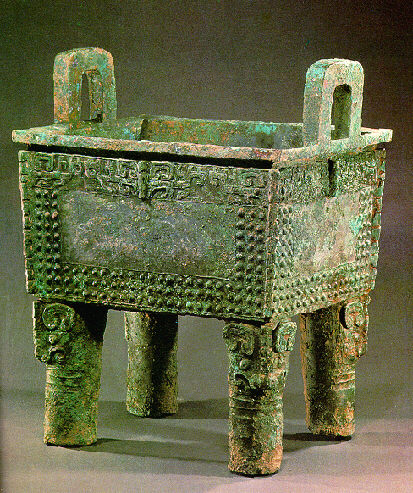

|
The development of metal-working technology represents a significant transition in Chinese history. The first known bronze vessels were found at Erlitou near the middle reaches of the Yellow River in northern central China. Most archaeologists now identify this site with the Xia dynasty (c. 2100-1600 BC) mentioned in ancient texts as the first of the three ancient dynasties (Xia, Shang, and Zhou). It was during the Shang (1600-1050 BC), however, that bronze-casting was perfected. Bronze was used for weapons, chariots, horse trappings, and above all for the ritual vessels with which the ruler would perform sacrifices to the ancestors. The high level of workmanship seen in the bronzes in Shang tombs suggests a stratified and highly organized society, with powerful rulers who were able to mobilize the human and material resources to mine, transport, and refine the ores, to manufacture and tool the clay models, cores, and molds used in the casting process, and to run the foundries. Altogether the bronzes found in Fu Hao's tomb weighed 1.6 metric tons, a sign of the enormous wealth of the royal family. These vessels were not only valuable by virtue of their material, a strong alloy of copper, tin, and lead, but also because of the difficult process of creating them. The piece-mold technique, used exclusively in China, required a great deal of time and skill. (In this Teacher's Guide, the hyperlink for the piece-mold technique is given below.)
The vessel below is a ding, used for food. Think about the piece-mold process. How do you think the technique affected the shapes and decoration on vessels such as this ding? (The hyperlink for decoration is given below in this Teachers' Guide.) |
|||||
|
|||||
 |
Many of the vessels were inscribed with Fu Hao's posthumous title, "Si Mu Xin." The rubbing of her title from the ding at left can be seen below.
|
||||
Bronze ding vessel Height: 80.1cm, Weight: 128kg
|
|||||
|
|||||
|
Click to see a drawing of its decoration. (In the Teachers's Guide, this is shown below.)
What creature is this zun supposed to represent?
|
|||||
|
Wine vessel Height: 46.3cm, Weight: 16kg
|
|||||
|
|||||
|
Can you make out what the decoration on this ax shows? Think about the contents of Fu Hao's tomb. What do you think this ax might have been used for? |
|||||
|
|||||
|
|||||
|
|
Click to see a drawing of the decoration on the bronze at left. (In this Teachers' Guide, shown below.) Why do you think zoomorphic images play such a large role in Shang art? |
||||
Covered container Height: 60cm, Length: 88cm, Weight: 71kg
|
|||||
|
|||||
|
|||||
|
Can you think of technical reasons for the projecting flanges on the body of the vessel to the left?
|
|||||
Drinking vessel
|
|||||
|
Move on to Jade from Fu Hao's tomb |
|||||